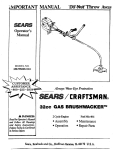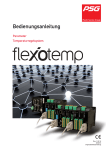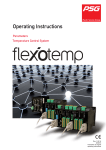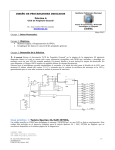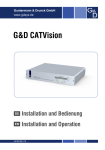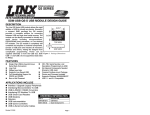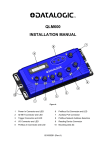Download MS Series Master Development System User's Guide
Transcript
MS Series Master Development System User's Guide ! Warning: Some customers may want Linx radio frequency (“RF”) products to control machinery or devices remotely, including machinery or devices that can cause death, bodily injuries, and/or property damage if improperly or inadvertently triggered, particularly in industrial settings or other applications implicating life-safety concerns (“Life and Property Safety Situations”). Table of Contents 1^ 2^ 2^ NO OEM LINX REMOTE CONTROL OR FUNCTION MODULE SHOULD EVER BE USED IN LIFE AND PROPERTY SAFETY SITUATIONS. No OEM Linx Remote Control or Function Module should be modified for Life and Property Safety Situations. Such modification cannot provide sufficient safety and will void the product’s regulatory certification and warranty. 3^ Customers may use our (non-Function) Modules, Antenna and Connectors as part of other systems in Life Safety Situations, but only with necessary and industry appropriate redundancies and in compliance with applicable safety standards, including without limitation, ANSI and NFPA standards. It is solely the responsibility of any Linx customer who uses one or more of these products to incorporate appropriate redundancies and safety standards for the Life and Property Safety Situation application. 6^ Do not use this or any Linx product to trigger an action directly from the data line or RSSI lines without a protocol or encoder/ decoder to validate the data. Without validation, any signal from another unrelated transmitter in the environment received by the module could inadvertently trigger the action. All RF products are susceptible to RF interference that can prevent communication. RF products without frequency agility or hopping implemented are more subject to interference. This module does not have a frequency hopping protocol built in. Do not use any Linx product over the limits in this data guide. Excessive voltage or extended operation at the maximum voltage could cause product failure. Exceeding the reflow temperature profile could cause product failure which is not immediately evident. Do not make any physical or electrical modifications to any Linx product. This will void the warranty and regulatory and UL certifications and may cause product failure which is not immediately evident. 4^ 4^ 5^ 5^ 9^ 12^ 13^ 14^ Introduction Ordering Information MS Series Encoder Development Board MS Series Deccoder Development Board Using the Development Boards Troubleshooting The Prototyping Area The Power Supply The Encoder Board The Decoder Board Installing the Software and Drivers MS Series Master Development System Software Schematics MS Series Master Development System User's Guide Figure 1: MS Series Master Development System Introduction The MS Series encoders and decoders are ideal for remote control and command, security, keyless entry, status monitoring and a host of similar applications. They allow the status of up to eight buttons or contacts to be securely transferred via a wireless link. The Master Development System gives a designer all the tools necessary to incorporate the MS Series into a product. This guide shows how to take full advantage of the development boards included with the system. The Master Development System serves several important functions: • Rapid Evaluation: It allows the performance and features of the MS Series encoder and decoder to be quickly evaluated. • Design: It shows how to design with the MS Series and how to interface with other components. It also demonstrates the overall system function, making it easy to develop the initial system design. • Prototype Development: It allows for additional circuitry to be placed directly on the board so that it can act as the first prototype of the product. All of the signals are available on a wire-wrap header for easy connection to external circuitry. This kit includes 2 development boards, 2 MS Series encoders*, 2 MS Series decoders*, and two CW Series antennas, 1 LR or ES Series transmitter, 1 LR or ES Series receiver, full documentation and batteries. The decoder board is populated with 1 QS Series USB module. *One part is soldered to the board, one extra is for use on your first prototype board. – 1 – Revised 3/18/2015 Ordering Information MS Series Deccoder Development Board Ordering Information Part Number Description MDEV-LICAL-MS MS Series Master Development System with LR Series MDEV-LICAL-MS-ES MS Series Master Development System with ES Series 5 8 9 1 Figure 2: Ordering Information MS Series Encoder Development Board 7 6 11 12 2 7 13 8 1 10 14 4 3 Figure 4: MS Series Deccoder Development Board 9 6 5 13 10 2 11 12 4 3 Figure 3: MS Series Encoder Development Board 1. 2. 3. 4. 5. 6. 7. 9V Battery Power Jack On-Off Switch Voltage Regulator Prototype Area Break-Out Header Reverse-Polarity SMA Antenna Connector 1. 2. 3. 4. 5. 6. 7. 8. 9V Battery Power Jack On-Off Switch Voltage Regulator QS Series USB Module Prototype Area Break-Out Header Reverse-Polarity SMA Antenna Connector 8. LR Series Transmitter Module 9. MS Series Encoder 10. Indicator LEDs 11. Function Switches 12. CREATE Button 13. Data Line Buttons – 2 – – 3 – 9. LR Series Receiver Module 10. MS Series Decoder 11. Data Line LEDs 12. Indicator LEDs 13. Function Switches 14. LEARN Button Using the Development Boards The Prototyping Area Use of the development boards is straightforward. After unpacking the development system, attach an antenna to each board, install the supplied 9V battery and turn on the power switches. The encoder and decoder are set at the factory and work straight out of the box. To create a new address, follow these steps: The prototyping area is the same on both boards and contains a large area of plated through holes so that external circuitry can be placed on the board. This circuitry can be interfaced with the MS encoder or decoder through the header to the right. At the bottom of this area is a row connected to the 3V power supply and at the top is a row connected to ground. 1. Press and hold the CREATE button on the encoder board to create a new Address. The Address is randomized for as long as the button is held down. Once comfortable that the number is sufficiently random, release the button. 2. Once the CREATE button is released, the MODE_IND LED begins to flash to indicate that it is ready to accept Control Permissions. Press all of the data line buttons that are to be authorized, then press the CREATE button again or let the encoder time out. 3. Press the LEARN button on the decoder board and the MODE_IND LED starts flashing. Press any of the data line buttons on the encoder board and press the LEARN button again or let the decoder time out. The encoder's Address has been learned by the decoder and they can now operate together. Troubleshooting If the boards fail to work out of the box, then try the following: • Check the battery to make sure it is not dead. • Make sure that the baud rate switches are set the same on both boards. • Make sure that the antenna is connected and has the correct polarity connector. • Check to see if the PDN switch is on, placing the encoder and decoder into Power Down Mode. In most cases, the encoder PDN switch should be in the up position. • Make sure that the Control Permissions are set correctly. If the encoder is not set to use a particular line, then when the button on the encoder board is pressed, the MODE_IND LED on the decoder board lights up, but the data line LED does not light up. All of the data lines are connected to a wire-wrap header to the right, allowing easy access from the prototyping area. The DATA_IN, DATA_OUT and TX_ID lines are also available on the header, as well as the PDN lines from the RF modules. This allows complete control of the entire system from the prototyping area, giving the designer a great deal of flexibility in using the boards. The Power Supply The power supply is the same on both boards and consists of a standard 9V battery and a power jack connected to a 3.0V voltage regulator. The regulator can provide approximately 500mA of current to the prototyping area. If the added circuitry needs more than this, then the designer must add an external supply. If the circuit consistently draws more than 100mA of current, it might be better to use the power jack, as the battery may run down fairly quickly, reducing testing and development time. The jack accepts a standard 5.5mm plug with the tip ground and the outer shell 7 to 16VDC positive supply. A reverse voltage protection diode is included on the board to protect the circuitry in case the voltage on the plug is reversed, but it is still a good idea to double-check the polarity. If all of these appear to be in order, then call +1 800 736 6677 or email [email protected] for technical support. – 4 – – 5 – The Encoder Board The encoder board has two sections that are of primary interest: the encoder area and the transmitter area. The Encoder Area Figure 5 shows the encoder area of the development board. Baud Rate Selection Table SEL_BAUD1 SEL_BAUD0 Baud Rate (bps) 0 0 2,400 0 1 9,600 1 0 19,200 1 1 28,800 Figure 6: Baud Rate Selection Table Note: The decoder board must be set to the same baud rate in order for the signal to be received correctly. The maximum baud rate for the LR Series is 10,000bps, so only 2,400 and 9,600bps can be used on boards populated with these modules. The ES Series transmitter can use all four baud rates. If the switch is up, then the line is high, if it is down, then the line is low. Figure 5: The Encoder Area The encoder is placed in the center beneath the Linx logo. To the right are buttons that pull the encoder data lines high when pressed. Button S0 corresponds to data line D0, S1 to D1 and so forth. The diodes to the left isolate the data lines from each other while allowing any line to activate the SEND line. Beneath the encoder are two LEDs. D12 is connected to the MODE_IND line and lights up as described in the MS Encoder Data Guide. D8 is connected to the TX_CNTL line and provides visual feedback by lighting up when the encoder sends a word. The PDN switch connects the TX_CNTL line of the encoder to the PDN line of the transmitter so that the TX Control Mode of the encoder can be tested. This mode is described in the MS Series Encoder Data Guide. If a BSEL switch is up, then the line is high (1, VCC); if down, then the line is low (0, GND). If the PDN switch is up, then the encoder’s TX_CNTL line is connected to the transmitter’s PDN line; if down, it is not connected and the LR Series transmitter is not activated unless its PDN line is pulled high externally. The ES Series transmitter has an internal pull-up, so is active unless pulled low. Beneath the LEDs is a button that is connected to the CREATE line. This button is used to create the Address and set the Control Permissions as described in the MS Series Encoder Data Guide. There are three function switches to the left of the CREATE button. BSEL0 and BSEL1 are used to set the baud rate of the encoder as described in Figure 6. The maximum baud rate for the LR Series is 10,000bps, so only 2,400 and 9,600bps can be used on boards populated with these modules. The ES Series can use all four baud rates. – 6 – – 7 – The Encoder Board RF Area Figure 7 shows the RF area of the development board. The Decoder Board The decoder board has three main sections of interest: the decoder area, the receiver area, and the USB area. The Decoder Area Figure 8 shows the decoder area of the development board. Figure 7: The Encoder Board RF Area This board can be populated with either the LR Series transmitter (as shown) or the ES Series transmitter. The LR Series transmitter is placed on the right side and the ANT1 connector is populated. The ES Series transmitter is placed on the left and the ANT2 connector is populated. R27 is connected to the LADJ line of the LR transmitter to reduce the output power to approximately 0dBm. The LR Series transmitter is capable of producing more output power than may be legally acceptable, so by reducing the output power, the range experienced with the evaluation kit more closely resembles the rage that can be achieved with a final certified product. Figure 8: The Decoder Area The decoder is placed in the center beneath the Linx logo. To the left are LEDs that are connected to the decoder data lines. These light up when the decoder receives a signal from the encoder to take the data line high. LED D0 corresponds to data line D0 and so forth. Beneath the decoder are two LEDs. D12 is connected to the MODE_IND line and lights up as described in the MS Series Decoder Data Guide. D8 is connected to the RX_CNTL line and provides visual feedback by lighting up when the decoder activates the receiver when in RX Control Mode. Beneath the LEDs is a button that is connected to the LEARN line. This button is used to learn the Address from the encoder as described in the MS Series Decoder Data Guide. There are four function switches to the left of the CREATE button. BSEL0 and BSEL1 are used to set the baud rate of the decoder as described in Figure 6. – 8 – – 9 – Note: The encoder board must be set to the same baud rate in order for the signal to be received correctly. The maximum baud rate for the LR Series is 10,000bps, so only 2,400 and 9,600bps can be used on boards populated with these modules. The ES Series receiver can use all four baud rates. If the switch is up, then the line is high, if it is down, then the line is low. The Decoder Board USB Area The decoder development board has a Linx SDM-USB-QS USB interface module for use with the included development software. The module is powered by the USB bus so does not pull any current from the battery. Figure 10 shows this section. The PDN switch connects the RX_CNTL line of the encoder to the PDN line of the receiver so that the RX Control Mode of the decoder can be tested. This mode is described in the MS Series Decoder Data Guide. The LATCH switch places the decoder into Latch Mode when on, so that the data lines will go high when a valid signal is received and stay high until a second valid signal is received. If the switch is off, the data lines are momentary. The Decoder Board RF Area Figure 9 shows the RF area of the development board. Figure 10: The Decoder Board USB Area The microcontroller on the right monitors the data lines and generates commands that are sent to the development software on the PC via the QS Series USB module. The RX_IND LED to the left of the module flashes to indicate that data is being received from the PC, and the TX_IND line flashes to indicate that the module is sending data to the PC. Figure 9: The Decoder Board RF Area This board can be populated with either the LR Series receiver (as shown) or the ES Series receiver. Both modules can be placed on the same pads in the center of the section, but the ANT1 connector is populated for the LR receiver and the ANT2 connector is populated for the ES receiver. – 10 – – 11 – Installing the Software and Drivers MS Series Master Development System Software The first time a QS module is plugged into a computer, Windows displays the Found New Hardware Wizard, which guides the installation of the drivers. The drivers are included on the CD, so point the wizard to the CD when prompted. The drivers have not gone through Microsoft’s verification process, so a message may appear warning of this. Click “Continue Anyway” to finish the installation process. The MS Series Master Development System software can be used in one of two modes. The default mode is as a simulation of the system. This is a good way of showing how the MS Series can work in a system for activating lights and doors. Application Note AN-00201 (Installing the SDM-USB-QS-S Drivers) describes the installation of the drivers in detail. The drivers should be installed before running the Development Software. The second mode is for use with the development system. When the decoder board is plugged into the USB port, the kit can be used to activate the features in the software. When a data line goes high on the decoder, the microcontroller sends a command to the computer to control the functions in the software. The MS Series Master Development System Software automatically starts when the CD is inserted and the player in Figure 11 appears. Exit Player Screen View Documentation Play Movie Install Software Selection Keypad Go to the Linx Website Figure 11: Software Installer The View Documentation button shows a list of the application notes and manuals related to the MS Series. Selecting one of these opens the file in Adobe Acrobat. The Play Movie button plays a short video about Linx in the Player Screen, which can be controlled with the Selection Keypad. Clicking the button on the bottom right of the player opens the Linx Technologies homepage in the computer’s default browser. Figure 12: The MS Series Master Development System Software Clicking the Help label at the top of the window opens the guide for using the development software. Please see this document for details on operation of the software. The View Documentation list also allows for the installation of Adobe Acrobat Reader, so that the documents may be viewed, and Flash, which may be required if the Linx video does not play correctly. Clicking the Install Software button starts the Installation Wizard, which guides the installation of the development software. The installer places the software application, MS Series documentation, and USB drivers at the installed location on the computer's hard drive. – 12 – – 13 – VCC 3 2 U2 VREG-3V Vout 3 VCC VREG-5V (ES RX ONLY) Vin C2 VREG-3V + C1 VREG-5V (ES RX ONLY) 10uF 220uF VCC VCC VREG-3V 2 VCC VCC POWER SWITCH U2 Vout VREG-5V (ES RX ONLY) GND U2 Vout 2 GND GND GND VCC VCC GND U2 Vout 2 + C1 C2 D9 + C1 B1 B1 220uF 10uF DIODE400 9V BATTERY 220uF 9V BATTERY C2 D9 C1 + B1 10uF DIODE400 220uF 9V BATTERY GND GND GND GND GND GND GND GND GND GND GND GND GND GND GND 9V BATTERY GND C2 10uF 1 D9 DIODE400 VREG-3V VREG-5V (ES RX ONLY) Vin SW15 SW Vb J1 PWRJACK Vb USB SECTION Figure 14: Power Supply Section USB USBSECTION SECTION USB SECTION GND GSHD GSHD 150 ohm GSHD GSHD 6 HSD_KEY_OUT GND DAT+ DAT 5V 4 3 2 1 GND 1 2 3 GND 4 5 R9 6 7 200 GND 8 GND GSHD GSHD GSHD 5 65 6 GSHD 6 GND IR KEY_OUT J2 USB-B 5 R24 4 3 2 GND DAT+ J2 DAT 1 USB-BJ2 5V USB-B 4 GND GND 3D11 4 GND DAT+ GND 3 2 DAT -DAT+ 2 1DAT 5V 1 RX_IND GND GND 5V 5 GND 150 ohm DATA_OUT TX_ID HSD_KEY_OUT J4 IR2 GND IR KEY_OUT IR2 R24 GND IR KEY_OUT DATA_OUT HSD_KEY_OUT TX_ID GND GND J4 J2 USB-B D11 D10 R10 D11 RX_IND 200 RX_IND GND GND GND GND TX_ID GND D10 D10 TX_IDTX_ID GND D11 R9 Figure 15: USB200Section RX_IND GND GND GND R9 200 R9 200 U7 1 RA2/AN2 2 RA3/AN3 3 RA4/AN4 4U7 RA5/MCLR 1 5 U7GND RA2/AN2 2 16 RA2/AN2 GND RA3/AN3 3 27 RA3/AN3 RB0/INT RA4/AN4 4 38 RA4/AN4 RB1 RA5/MCLR 5 49 RA5/MCLR RB2/RX 5 GND 610 GND GND RB3 76 U5 16 RI USBDP 15 USBDM DCD 14 GND DSR 13 U5 VCC DATA IN DATA_PC 12 1SUSPU5 IND DATA OUTRI 16 USBDP 16 1 11 2RX INDUSBDP RI15 RTS USBDM DCD 10 2 15 3TX INDUSBDM DCD14 CTS GND DSR 3 14 9 4485 TXGND DTR DSR13 VCC DATA IN 5 4 VCC 12 SUSP IND DATA DATA OUT IN 6 5 SUSP IND DATA OUT11 SDM-USB-QS RX IND RTS 7 6 RX IND 10 TX CTSRTS 7 IND 8 TX IND CTS9 485 DTR 8 TX 485 TX DTR 16 SDM-USB-QS SDM-USB-QS U5 1R10 USBDP R10 2 200USBDM 200 3 GND 4 VCC 5 SUSP IND 6 RX IND 7 TX IND 8 485 TX RI DCD DSR DATA IN DATA OUT RTS CTS DTR 15 14 13 12 11 10 9 D3 D2 GND GND GND GND D3 D2D3 D2 D1 GND GND D0 GND GND TX_IDGND GND GND GND 13 DATA_PC DATA_PC 12 11 10 9 GND D1 D1 D0 D0 TX_ID TX_ID D3 GND GND D2 DATA_PC D1 D0 TX_ID SDM-USB-QS R10 D10 GND SW13 SW11 VCC VCC TX_IDVCC GND GND GND GND RA1/AN1 RA0/AN0 RA7 RA6 20 RA1/AN1VCC20 19 RA1/AN1 VCC RA0/AN0 19 18 RA0/AN0 RB7/AN6 RA7 18 17 RA7 RB6/AN5 RA6 17 RA6 16 RB5/TX VCC 16 15 VCC VCC RB4 15 14 GND VCC RB0/INT RB7/AN6 8 7 PIC16LF88 RB0/INT RB7/AN6 RB6/AN5 8 RB1 U7 RB1 RB6/AN5 9 9 RB2/RX RB5/TX 1 1010 RB2/RX RA2/AN2 RB5/TX RB4 RB3 RB3 RB4 2 RA3/AN3 PIC16LF88 3 PIC16LF88 RA4/AN4 RA5/MCLR GND GND RB0/INT RB1 RB2/RX RB3 4 5 6 7 8 9 10 GND 200 TX_ID 20 D4 19 D5 18 D6 17 D7 16 D4 VCC 15 D4 D5 VCC 14 D5 D6 LATCH 13 D6 D7 GND 12 D7 VCCDATA_PC 11 VCC VCCGND VCC LATCH 14 13 LATCH GND 13 GND 12 12 DATA_PC DATA_PC20 11 RA1/AN1 11 GND GND 19 RA0/AN0 RA7 RA6 VCC VCC RB7/AN6 RB6/AN5 RB5/TX RB4 PIC16LF88 RF SECTION SW9 J4 HS_SEND_KEY GND RFSECTION SECTION RF SEND 0.01uF GND R11 GND 200 R11 GND 200 100K GND D7_IND D5_IND D7_IND D6_IND D6 D7 D7 R6 R7 100K GND 100K GND R7 R11 200 GND R5 R6R7 100K 100K GND 100K GND GND D5 D7 D6 D6_IND D4_IND D5_IND R6 R4 R5 100K 100K 100K GND GND D5_IND D6 D5D4 D3_IND D4_IND R5 R4 R3 100K 100K GND 100K GND GND D4_IND D5 D4D3 D2_IND D3_IND R2 GND GND R3 100K GND 100K 100K D4 D3D2 R1 R2100K GND 100K 100K GND GND R4 D1_IND D2_IND D3_IND D3 D1_IND D0_IND D1D0 D2_IND D0_IND D2 D2D1 R3 R1100K R0 GND 100K 100K GND GND R1 100K GND R2 R0 R0100K GND D1_IND D1 D0_IND D0 GND D0 100K GND R7 1 2 GND 3 GND VCC 4 6 PDN U4 LR RF ES RF GND GND ES PDN NC GND U8 5 PDN VCC1 1 PDN PDN CON14 5 4 3 2 1 100K GND CON14 PDN 9 D4 D7 DEC_DATA 8 D5 DATA_OUT 7 D6 TX_ID 6 D7_IND D7 GNDPDN 5 R11 4 DEC_DATA 200 3 DATA_OUT 2 TX_ID GND 1 13 D0 12 D1 D4_IND R4 11 D2 10 D3 100KJ3 9 D5 D4 GND 8 D5 GND 14 7 D6 13 D0 D5_IND 6 D7 R5 12 D1 5 PDN 11 D2 J3 4 DEC_DATA 100K 10 D3 39 14D6 DATA_OUT GND D4 GND 28 13 TX_ID D5 D0 GNDD1 17 12 D6_IND D6 R6 6 11 D7 D2 CON14 10 D3 R3 J3 100K 14 GND GND D4 GND GND GND D3 GND R16 C4 9.1M 4.7uF D3_IND GND R2 SW8 SW-PB 100K GND GND GND R14 C45.1M 4.7uF R16 D2_IND 9.1M GND D2 100K SW-PB GND D6_IND D7_IND SEND SEND C5 GND GND 10K C5 R18 0.01uF 9.1M R20 51K IR1 PS1102 TLV2302 8 7 6 5 8 AOUT VCC 7 AIN- COUT 6 CINAIN+ 5 GND CIN+ U6 TLV2302 1 AOUT VCC 2 AIN- COUT 3 AIN+ CIN4 GND CIN+ U6 16 LR RF 16 ANT1 ANT1 REVSMAPCB RF1 REVSMAPCB RF1 RF1 RF1 RF1 RF1 GND GND GND 14 PDN PDN PDN 15 1 U8 ES RSSI U8 PDN 16 12 DEC_DATA DEC_DATA DEC_DATA 11 9 GND GND GND ANT1 REVSMAPCB RF1 GND 14 GND PDN 13 RF RFGND 11 2 9 3 2 LR VCC PDN GND LVL/AM LV 9DET VCC ES AUDIO GND LVL/AM 10 RF2 GND DEC_DATA 9 RF2 RF2 GND 8 GND DATA_OUT GND GND GND 3 8 7 4 7 10 3 DET8SEL GND LV DET /CLK VCC VCC LRGND RSSIVCC VCCES AUDIOLVREF DEC_DATA GND 4 8 DATA_OUT GND 4 5 GND DATA GND LR DATA 5 DATA_OUT 7 7 9 /CLK SEL/CLK /CLK SEL TXM-xxx-ES DATA 5 DATA DATA_OUT RXM-XXX-LR TXM-xxx-ES TXM-xxx-ES RXM-XXX-ES NC /CLK6 ANT2 ANT2 REVSMAPCB REVSMAPCB ANT2 REVSMAPCB RF2 RF2 RF2 10 RF1 15 RF 12 ES DATA 10 10 2 PDN PDN LVL/AM GND GND 13 DATA_OUT GND DATA_OUT R27 GND GND 620ohm R27 VCC 6 VCC VCC 6 /CLK Figure 16: RF Section – 14 – GND RF SECTION GND 1 2 3 4 9.1M 9.1M R17 GND D1_IND R14 5.1M GND VCC SW8 R1 GND ES U4 RF U4 1 RF2 LR RF16 ES RF 1 2 RF2 LR RF 15 GND GNDES RF GND 2 GND 2 GND15 GND GND 3 NC GND GND 14 ES PDN 3 ES PDN14 NC 3 4 NC ES PDN 13 GND 4 ES RSSI GND ES RSSI13 GND 4 GND GND 5 GND ES RSSI 12 VCC 5 VCC VCC ES DATA ES DATA VCC 5 12 VCC 6 VCC ES DATA 11 6 ES AUDIO LR PDN PDN ES AUDIO LR PDN PDN 6 11 PDN LR PDN ES AUDIO10 7 7 ES AUDIO REF REF LR RSSI ES AUDIO LR RSSI 7 10 LR ES AUDIO REF 8 RSSI 8 9 NC NC DEC_DATADEC_DATA LR DATALR DATA 8 9 DEC_DATA LR DATA NC RXM-XXX-LR RXM-XXX-LR RXM-XXX-ES RXM-XXX-LR RXM-XXX-ES RXM-XXX-ES RF2 Figure 13: Figure 11: Encoder / Decoder Section ANT1 REVSMAPCB U4 1 RF2 100K GND VCC VCC GND R19 IR110K PS1102 IR1 HS-ENC GND 9.1M R16 9.1MR15 SW-PB R0 100K GND VCC C4 D1 4.7uF R15 9.1M D0_IND R17 VCC R14 5.1M D0 SW8 GND R19PS1102 10K R20 51K 100K C5 R28 R20 R18 51K R21 9.1M R21 10K 0.01uF 100K R18 GND 9.1M R28 10K VCC R28 VCC HS-ENC U6 1 8 AOUT VCC 2 SEND 7 AIN- COUT 3 6 AIN+ CIN4 5 GND CIN+ TLV2302 GND DATA_OUT LATCH R12 100k VCC R21 100K R19 10K VCC 9.1M VCC POWER SWITCH Va SW15 POWER SW Vb SWITCH D9J1 Va B1 SW15 SWITCH PWRJACK Vb DIODE400 SW POWER Vb 150 ohm D6 IR2 HS_CREATE_KEY D7 SEL_BAUD1 SEL_BAUD0 R24 LICAL-XXX-MS SEL_BAUD0 SW14 SEL_BAUD1/HSE_GND/HSD_SEND_KEY LICAL-XXX-HS GND SW12PDN GND GND U1 ohm GND IR KEY_OUT GND 150 GND GND GND SEL_BAUD0 SW12 SW11 VCC GND GND SW9 HS_SEND_KEY GND R15 9.1M R17 SW15 SW Vb 1 S2 S5D7 Va PWRJACK Vb D4 D5 VCC J1 S7 D5 D4 D3 D2 VCC VCC D1 D0 SEL_BAUD1 ENCODER / DECODER SECTION D5 D6 D4 D7 SEL_BAUD0 D3 SEL_BAUD1/HSE_GND/HSD_SEND_KEY D2 D7 VCC GND GND VCC KEY_IN/MSE_GND/MSD_LATCH D1 D6 TX_CNTL/MSD_RX_CNTL/HSD_CREATE_KEY D0 U1 DATA_OUT/MSD_TX_ID/HSD_KEY_OUT SEND/DEC_DATA_IN D5 D5 MODE_IND CREATE_ADDR/DEC_LEARN D7 D6 U1 200 GND MODE_IND SEL_BAUD0 SW12 VCC R22 100k 200 VCC R8 R13 100k HS_KEY_IN 0.01uF HS-ENC GND VCC Va PWRJACK Vb 13 1 GND GND Vin 3 GND Vin D1 D4 D4 S1 S4D6 D3 D3 D0 S6 SW10 D2 D6 D2 D3 S0 VCC VCC VCC DEC_DATA VCC S3D5 VCC VCC S5 R12SW9 D5 D6 D5 D2 R23 R26 HSD_KEY_OUT KEY_IN/MSE_GND/MSD_LATCH D1 D1 LATCH SW16 100k SW13 PDN D4 LATCH D4 D0 D4 D0 D7 HS_SEND_KEY 0K 100K SEL_BAUD1 S2 TX_CNTL/MSD_RX_CNTL/HSD_CREATE_KEY J5 S4 SEL_BAUD0 D3 D3 CREATE/LEARN VCC DATA_OUT/MSD_TX_ID/HSD_KEY_OUT SEND/DEC_DATA_IN D12 D1 D2 D2 TX_EN SEL_BAUD1/HSE_GND/HSD_SEND_KEY D3 MODE_IND CREATE_ADDR/DEC_LEARN HS_CREATE_KEY S1 GND SEND GND GND VCC VCC R25 D8 S3 GND GND VCC VCC GND LICAL-XXX-MS D0 R12 GND SW14 D2 200 KEY_IN/MSE_GND/MSD_LATCH D1 D1 LATCH SW10 GND LICAL-XXX-HS HS_KEY_IN 100k S0 VCC PDN SW13 R13 MODE_IND DEC_DATA S2 D0 D0 R8 R22 TX_CNTL/MSD_RX_CNTL/HSD_CREATE_KEY 100k VCC D1 200 100kDATA_OUT/MSD_TX_ID/HSD_KEY_OUT SEND/DEC_DATA_IN R23 R26 SW16 MODE_IND CREATE_ADDR/DEC_LEARN HS_CREATE_KEY LATCH PDN S1 GND 0K 100K J5 CREATE/LEARN LICAL-XXX-MS D0 D12 SW10 SW14 TX_EN GND PDN LICAL-XXX-HS S0 VCC SEND GND R25 DEC_DATA D8 GND GND GND GND R23 R26 200 SW16 HS_KEY_IN LATCH R13 PDN MODE_IND 0K 100K R8 R22 J5 DATA_OUT 100k CREATE/LEARN 200 TX_ID D12 TX_EN100k SEND R25 D8 J4 IR2 GND GND GNDGND 200 HS_KEY_IN R13 GND GND R24 MODE_IND R8 R22 100k GND 200 100k D2 D3 S3 D6 S6 D4 S7 D7 S5 J1 Schematics VCC S4 D5 D6 S6 POWER SUPPLY SECTION POWER SUPPLY SECTION – 15 – R27 620ohm 620ohm U3 8 1 PDN GND U3U3 87 8 1 21 PDN GND ANT2 VCC DATA PDN GND IN REVSMAPCB 2 32 76 7 VCC DATA IN IN GND GND VCC DATA 3 43 4 RF2 GND LADJ/VCC GND TXM-xxx-LR 65 6 RFGND OUT GND 5 RF OUT 4 LADJ/VCC RF OUT LADJ/VCC TXM-xxx-LR GND TXM-xxx-LR 5 PDN PDN VCCPDN VCC GNDVCC GNDGND RF1 RF1 RF1 18 17 16 15 14 13 12 11 D4 D5 D6 D7 VCC VCC LATCH GND DATA_PC GND Linx Technologies 159 Ort Lane Merlin, OR, US 97532 Phone: +1 541 471 6256 Fax: +1 541 471 6251 www.linxtechnologies.com Disclaimer Linx Technologies is continually striving to improve the quality and function of its products. For this reason, we reserve the right to make changes to our products without notice. The information contained in this Data Guide is believed to be accurate as of the time of publication. Specifications are based on representative lot samples. Values may vary from lot-to-lot and are not guaranteed. “Typical” parameters can and do vary over lots and application. Linx Technologies makes no guarantee, warranty, or representation regarding the suitability of any product for use in any specific application. It is the customer’s responsibility to verify the suitability of the part for the intended application. NO LINX PRODUCT IS INTENDED FOR USE IN ANY APPLICATION WHERE THE SAFETY OF LIFE OR PROPERTY IS AT RISK. Linx Technologies DISCLAIMS ALL WARRANTIES OF MERCHANTABILITY AND FITNESS FOR A PARTICULAR PURPOSE. IN NO EVENT SHALL LINX TECHNOLOGIES BE LIABLE FOR ANY OF CUSTOMER’S INCIDENTAL OR CONSEQUENTIAL DAMAGES ARISING IN ANY WAY FROM ANY DEFECTIVE OR NON-CONFORMING PRODUCTS OR FOR ANY OTHER BREACH OF CONTRACT BY LINX TECHNOLOGIES. The limitations on Linx Technologies’ liability are applicable to any and all claims or theories of recovery asserted by Customer, including, without limitation, breach of contract, breach of warranty, strict liability, or negligence. Customer assumes all liability (including, without limitation, liability for injury to person or property, economic loss, or business interruption) for all claims, including claims from third parties, arising from the use of the Products. The Customer will indemnify, defend, protect, and hold harmless Linx Technologies and its officers, employees, subsidiaries, affiliates, distributors, and representatives from and against all claims, damages, actions, suits, proceedings, demands, assessments, adjustments, costs, and expenses incurred by Linx Technologies as a result of or arising from any Products sold by Linx Technologies to Customer. Under no conditions will Linx Technologies be responsible for losses arising from the use or failure of the device in any application, other than the repair, replacement, or refund limited to the original product purchase price. Devices described in this publication may contain proprietary, patented, or copyrighted techniques, components, or materials. Under no circumstances shall any user be conveyed any license or right to the use or ownership of such items. ©2015 Linx Technologies. All rights reserved. The stylized Linx logo, Wireless Made Simple, WiSE, CipherLinx and the stylized CL logo are trademarks of Linx Technologies.













